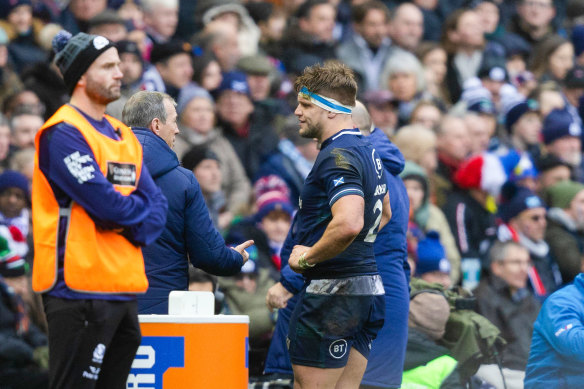This was published 8 months ago
‘Smart mouthguards’ in spotlight after Scottish player forced from Six Nations game
By Ben Coles
Scotland hooker George Turner became the first player in the Six Nations to be forced off the field for a head injury assessment triggered by his “smart mouthguard”.
In what is believed to be the first use of the new technology introduced by World Rugby ahead of the start of this year’s championship, Turner was replaced on 17 minutes by Ewan Ashman and appeared surprised as he left the field.
Scotland believe the alert was triggered when France’s Charles Ollivon was brought down by Turner following the restart in the 12th minute after a penalty by Thomas Ramos.
Turner executed what appeared to be a normal tackle on Ollivon when the clock showed 11:48, but the hooker was not replaced until 16:30. In the time delay until he was replaced, Turner also notably carried into a big collision with France prop Uini Atonio around 45 seconds before he was taken off.
The Glasgow Warriors forward eventually returned to have a major impact in Scotland’s dominant first half, but Gregor Townsend expressed caution about the new technology, urging the need to use it correctly to avoid having an unintended impact on Test matches.
“I don’t think there was any more that came out of it but we just have to watch what we’re doing here with bringing technology in that might have an influence for not the correct reasons, let’s say,” Townsend said.

Scotland’s George Turner leaves the field for an HIA during the Six Nations match against France on Sunday (AEDT).Credit: Getty
“But thankfully George came back on after 10 minutes and I thought Ewan Ashman played really well in that period, and did when he came off the bench at the end too.”
The smart mouthguards work in real time, sending alerts of high forces to the independent match-day doctor. Players who have experienced a high acceleration event, but not showing symptoms or been seen by broadcast cameras, can then be taken off and assessed.
Current regulations state that for men’s players an impact above 70G and 4000 radians per second squared will recommend a HIA, with lower thresholds of 55G and 4000 rad/s² for women’s players.
To put the collision into context, ex-Formula One driver Romain Grosjean experienced an impact of 67G when he suffered his fireball crash in the 2020 Bahrain Grand Prix, while Max Verstappen experienced a 51G force when he crashed at the 2021 British Grand Prix after colliding with Lewis Hamilton.
World Rugby announced in October last year that they were investing an initial €2 million ($3.3 million) to support unions, competitions and clubs by adopting the new smart mouthguard technology, which are supplied by Prevent Biometrics.
Telegraph, London
All three episodes of the brand new Stan Original Documentary Series The Wallabies - Inside Rugby World Cup 2023 premiere February 22, only on Stan.